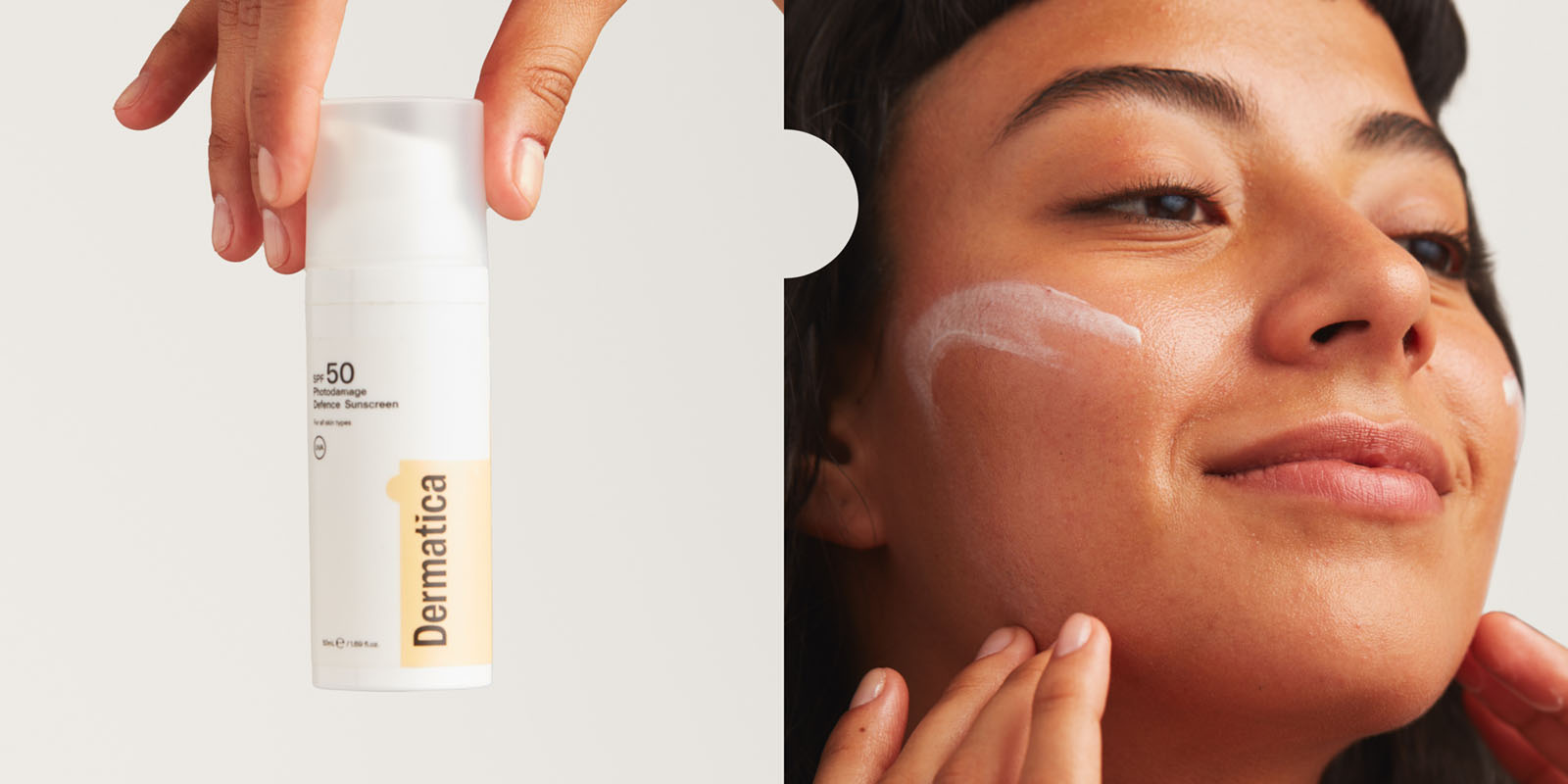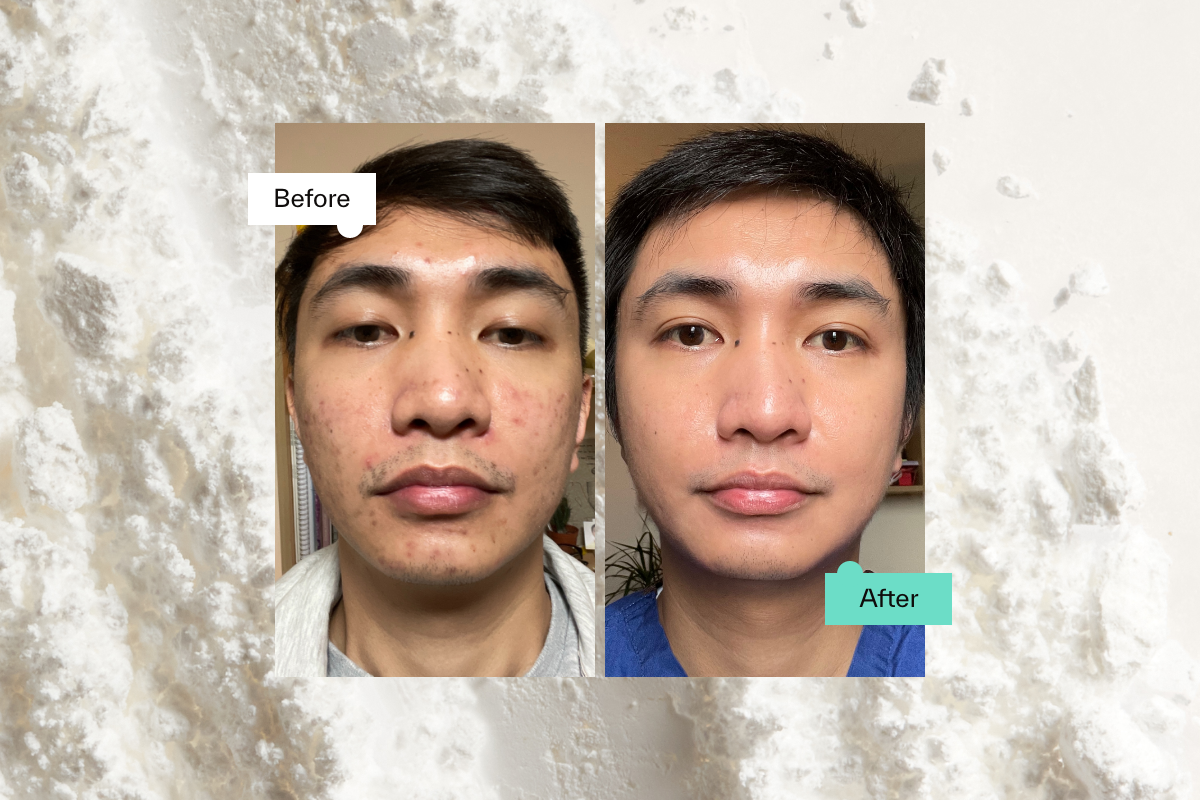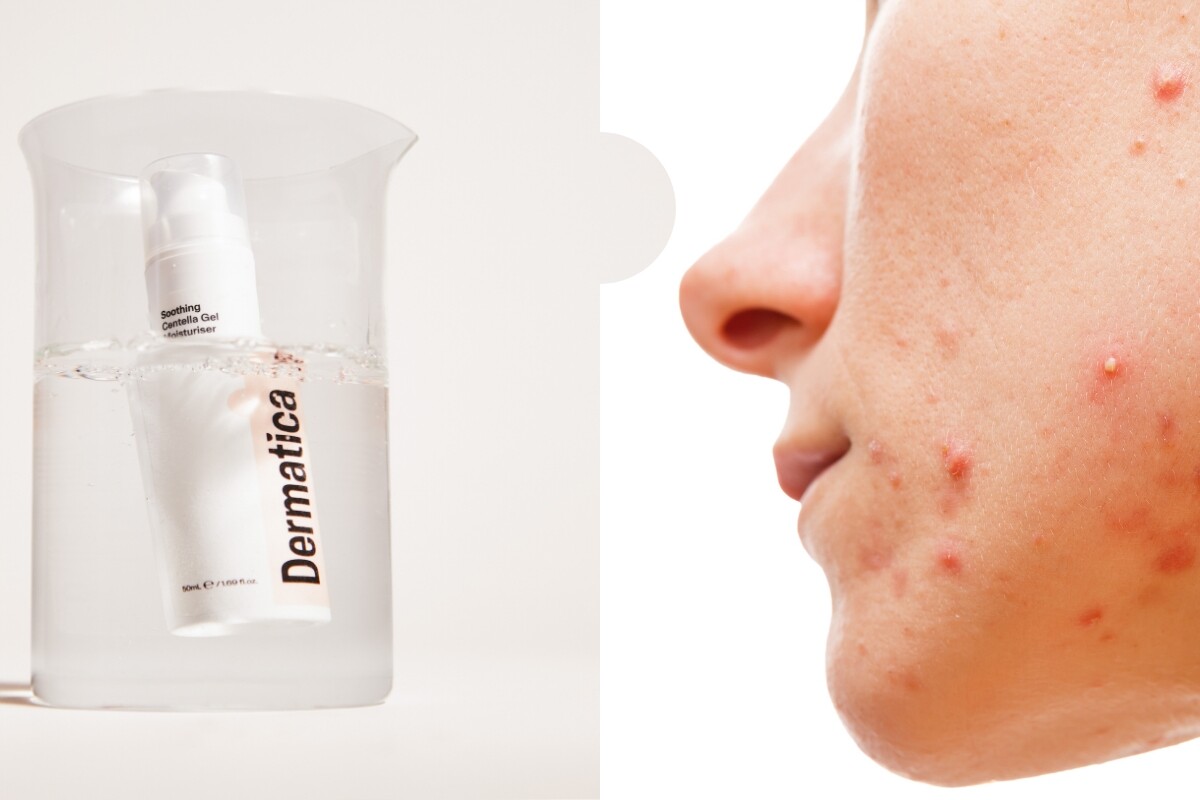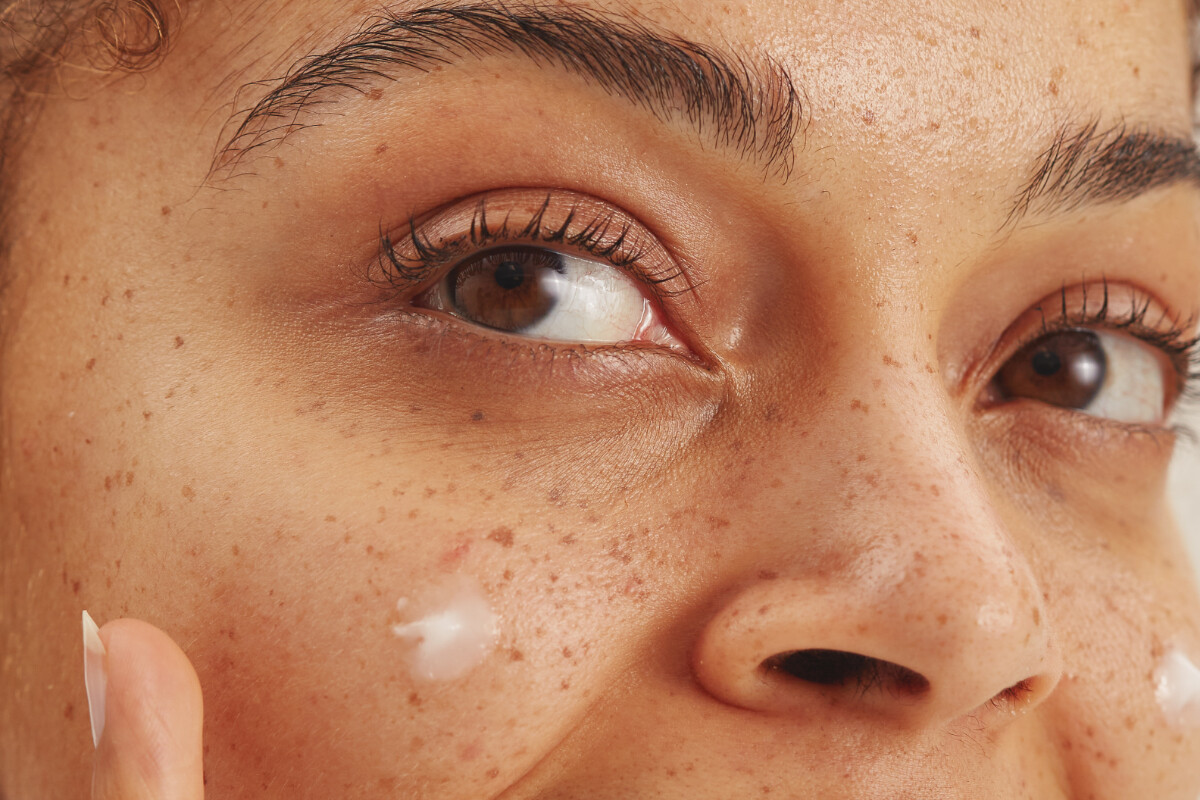Sunscreen, though essential, can be confusing when you find out there isn’t just one type. So how do you know if a sunscreen has chemical or mineral filters? And how do you choose the right one for you? Let’s deconstruct the clinical and scientific language around these two types of sunscreen filters, so we can help you make the right sunscreen decision for your skin type.
Why Sunscreen is Important for Skin Health
A sunscreen – or UV – filter is the active ingredient responsible for shielding your skin from the dangers of sun exposure and the damaging effects of ultraviolet (UV) radiation. There are two different types of UV rays – called UVA and UVB. While UVB rays cause sunburn, UVA rays penetrate deep into the skin’s dermis.
The Role of Sunscreen in Protecting Against UV Damage
UVA rays cause accelerated skin ageing because they can degrade collagen and alter the elastin fibres in your skin at the cellular level. UV rays therefore cause pigmentation, accelerated skin ageing, and photodamage – and may lead to skin cancer. (1)
The Importance Of Choosing The Right Sunscreen
We always recommend wearing broad-spectrum sunscreen with at least SPF 30+. While SPF 30 filters approximately 97% of UVB rays, (2) SPF 50 provides a slightly higher level of protection, filtering around 98% of these rays. (3) The difference may seem modest, but it becomes more important if you’re exposed to the sun for long periods. Regardless of SPF rating, it’s important to apply enough broad-spectrum sunscreen, correctly, and reapply every two hours (or after swimming or sweating).
UVA (long wave) rays are as harmful as UVB rays, and are the number one cause of premature skin ageing and deeper skin damage. However, SPF ratings don’t explicitly measure protection against UVA rays. To find out if your sunscreen has UVA protection, always look for a broad-spectrum sunscreen that says it shields against both UVA and UVB rays.
Some sunscreens may also include a separate UVA rating to show they protect against UVA rays. Making sure you have broad-spectrum protection against both types of ultraviolet rays is essential for maintaining your overall skin health, preventing accelerated skin ageing and long-term damage while lowering your risk of skin cancer. (4)
Understanding The Difference Between Mineral And Chemical Sunscreens
Broad-spectrum sunscreen filters can shield your skin from both types of UV rays and the dangers of sun exposure. They are chemical filters (organic) and mineral filters (inorganic or physical). (2)
Mineral sunscreens, often referred to as physical sunscreen or inorganic sunscreen, use natural mineral ingredients such as zinc oxide, iron oxide or titanium dioxide to protect the skin from UV exposure. Physical UV filters create a physical barrier on the outer layer of the skin, reflecting and scattering UV rays before they can penetrate the skin. The broad-spectrum protection they offer makes physical formulas an excellent choice for those seeking natural and immediate sun protection. (5)
Chemical sunscreens, also known as organic or synthetic sunscreens, contain active ingredients such as avobenzone, octocrylene, or oxybenzone. These common chemical UV filters work by absorbing UV light through a chemical reaction and transforming it into heat, which is then released from the skin. This mechanism allows for a lighter formulation, making chemical formulas comfortable and easy to use – even on acne-prone and sensitive skin types. (6)
Pros and Cons of Mineral Sunscreens
The Benefits of Mineral Sunscreens For Sensitive Skin Types
– Broad-spectrum protection against both UVA and UVB rays
– Less likely to cause skin irritation or reaction for sensitive, allergic, delicate, acne-prone and sensitive skin types
– Effective as soon as you apply it (you don’t need to wait before going out in the sun)
– May also protect against blue light from laptop and phone screens (7)
The Challenge of White Casts in Mineral Sunscreens
– Some physical sunscreens can leave a shine or white cast on deeper skin tones
– They can feel heavier on the skin compared to chemical sunscreens
– Typically have lower sun protection factor (SPF) ratings than chemical sunscreen (8)
Pros and Cons of Chemical Sunscreens
The Benefits of Chemical Sunscreens
– Chemical sunscreen formulas have a lightweight formula, making them smoother to apply
– Less likely to leave a white cast on darker skin types
– Suitable for a broader range of skin types, including sensitive skin types
The Drawbacks of Chemical Filters
– Some individuals may experience skin sensitivity or skin irritation
– You’ll need to wait about 20 minutes before going in the sun
Choosing the right type of sunscreen for your skin type
For Oily Skin or Acne-Prone Skin:
If you have oily or acne-prone skin, you can opt for either a chemical or mineral sunscreen. Just make sure they’re fragrance and alcohol free. The difference between chemical sunscreens and mineral ones is their lighter texture. However if you have sensitive or acne-prone skin then you may opt for a mineral version. It’s up to your personal preference and individual skin type. Just look for non-comedogenic formulations – this means the ingredients won’t clog your pores. (9)
For Balanced or Dry Skin:
Chemical sunscreen formulations like our SPF 50 Photodamage Defence Sunscreen are a fantastic choice for those with dry or balanced skin, as the lighter formulation is smooth to apply, suitable for sensitive skin and less likely to leave a white cast on darker skin types.
For Rosacea:
Choosing a mineral sunscreen formula that’s designed for sensitive skin, like a titanium dioxide or zinc sunscreen, will help minimise any irritation. Regardless of the weather, effective sun protection is vital because even the slightest UV exposure can risk a flare-up. If you’re out in the sun for hours, apply two finger-lengths’ worth of sunscreen all over your face at least every two hours. Especially during peak sunlight hours. You should also make sure your skin is protected year-round with UV visors, wide-brimmed hats and/or sunglasses, as factors like altitude, snow, water, and eyeglasses can enhance the impact of ultraviolet rays. (10)
Daily sun protection is particularly important if you have rosacea, as sun exposure is a top trigger for flare-ups. It’s also linked to the appearance of visible blood vessels and severe redness. Choosing non-chemical, broad-spectrum (UVA & UVB) sunscreens with zinc or titanium dioxide and SPF 30+ is crucial.
Sunscreen’s Impact on Coral Reefs
It’s important to be aware of how chemical sunscreen ingredients can impact our ocean life and coral reefs. Certain chemicals found in some sunscreens, such as oxybenzone, octocrylene and octinoxate, have been widely studied and identified as harmful to ocean life and coral ecosystems. These substances can contribute to coral bleaching, disrupt coral reproduction, and harm marine life. If you’re going to be using your sunscreen at the beach, make sure you check the ingredients list to make sure yours is safe for coral reefs and marine life. (11)
Are Mineral or Chemical Sunscreens Better For Active Ingredients?
Both mineral and chemical sunscreens can be used safely with active ingredients in your skincare routine, like using a Dermatica personalised formula for example. In fact, it’s incredibly important that you apply sunscreen while using retinoids, as the sun can affect how well these ingredients work on your skin. (12)
Whether you opt for the immediate protection of a mineral sunscreen formulation, or the lightweight feel of a chemical one, make sure you apply sunscreen every morning without fail. Broad-spectrum protection is your skin’s strongest defence against the negative effects of UV rays. It prevents premature skin ageing, sun damage, unwanted pigmentation and – most notably – skin cancer.
Want to ask for advice from a dermatology expert? If you’re already a Dermatica subscriber, you can reach out to us via your dashboard and we’ll let you know whether chemical sunscreen filters or mineral sunscreen filters are best for your skin type. If you haven’t signed up yet, you can ask for advice from our team, whenever you need. They’ll also create a personalised formula that’s made specifically for your skin and the areas or concerns you want to focus on – including sun damage. It only takes 2 minutes.
References
1. Shanbhag S, Nayak A, Narayan R, Nayak U. Anti-aging and Sunscreens: Paradigm Shift in Cosmetics. Adv Pharm Bull [Internet]. 2019;2019(3):348–59. Available from: https://apb.tbzmed.ac.ir/Files/Inpress/apb-24144.pdf
2. Gabros S, Zito PM. Sunscreens And Photoprotection [Internet]. Nih.gov. StatPearls Publishing; 2019. Available from: https://www.ncbi.nlm.nih.gov/books/NBK537164/
3. Dale Wilson B, Moon S, Armstrong F. Comprehensive Review of Ultraviolet Radiation and the Current Status on Sunscreens. The Journal of Clinical and Aesthetic Dermatology [Internet]. 2012 Sep 1;5(9):18–23. Available from: https://www.ncbi.nlm.nih.gov/pmc/articles/PMC3460660/
4. Geoffrey K, Mwangi AN, Maru SM. Sunscreen products: Rationale for use, formulation development and regulatory considerations. Saudi Pharmaceutical Journal. 2019 Nov;27(7):1009–18.
5. D’Orazio J, Jarrett S, Amaro-Ortiz A, Scott T. UV radiation and the skin. International Journal of Molecular Sciences [Internet]. 2013 Jun 7;14(6):12222–48. Available from: https://www.ncbi.nlm.nih.gov/pmc/articles/PMC3709783/
6. Jesus A, Mota S, Torres A, Cruz MT, Sousa E, Almeida IF, et al. Antioxidants in Sunscreens: Which and What For? Antioxidants [Internet]. 2023 Jan 1 [cited 2023 Jan 19];12(1):138. Available from: https://www.mdpi.com/2076-3921/12/1/138
7. Varedi A, Wu YP, Klein SZ, Leachman SA, Grossman D. Mineral sunscreens not recommended by Consumer Reports: What lies beneath the surface? Journal of the American Academy of Dermatology [Internet]. 2019 Mar 1;80(3):832–3. Available from: https://www.ncbi.nlm.nih.gov/pmc/articles/PMC7479990/
8. Passeron T, Lim HW, Goh C ‐L., Kang HY, Ly F, Morita A, et al. Photoprotection according to skin phototype and dermatoses: practical recommendations from an expert panel. Journal of the European Academy of Dermatology and Venereology [Internet]. 2021 Jul 1;35(7):1460–9. Available from: https://www.ncbi.nlm.nih.gov/pmc/articles/PMC8252523/
9. Gabros S, Zito PM. Sunscreens And Photoprotection [Internet]. Nih.gov. StatPearls Publishing; 2019. Available from: https://www.ncbi.nlm.nih.gov/books/NBK537164/
10. Farshchian M, Daveluy S. Rosacea [Internet]. PubMed. Treasure Island (FL): StatPearls Publishing; 2023 [cited 2024 Jan 18]. Available from: https://www.ncbi.nlm.nih.gov/books/NBK557574/
11. Chatzigianni M, Pavlou P, Siamidi A, Vlachou M, Varvaresou A, Papageorgiou S. Environmental impacts due to the use of sunscreen products: a mini-review. Ecotoxicology. 2022 Sep 29;
12. Quan T. Human Skin Aging and the Anti-Aging Properties of Retinol. Biomolecules [Internet]. 2023 Nov 1 [cited 2023 Nov 28];13(11):1614. Available from: https://www.mdpi.com/2218-273X/13/11/1614
Ash Sharma
Dr Ashwin Sharma is a medical doctor and writer with a particular interest in health technology, artificial intelligence and medical weight loss. He completed his training at the University of Leicester and Imperial College London, and has since been exploring the intersections of medicine, technology, and communication.





